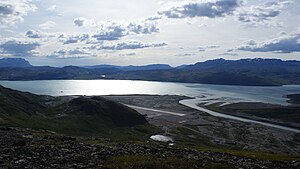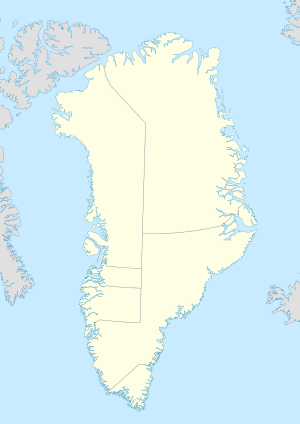Narsarsuaq
| Narsarsuaq | |
|---|---|

Narsarsuaq and Tunulliarfik Fjord
|
|
| Location within Greenland | |
| Coordinates: 61°08′45″N 45°26′05″W / 61.14583°N 45.43472°WCoordinates: 61°08′45″N 45°26′05″W / 61.14583°N 45.43472°W | |
| State |
|
| Constituent country |
|
| Municipality |
|
| Government | |
| • Mayor | Jørgen Lund |
| Population (2015) | |
| • Total | 145 |
| Time zone | UTC-03 |
| Postal code | 3923 |
Narsarsuaq (lit. Great Plan; old spelling: Narssarssuaq) is a settlement in the Kujalleq municipality in southern Greenland. It had 158 inhabitants in 2010. There is a thriving tourism industry in and around Narsarsuaq, whose attractions include a great diversity of wildlife, gemstones, tours to glaciers, and an airfield museum.
Narsarsuaq is located within the Eastern Settlement of the Greenlandic Norse; the Brattahlíð farm of Erik the Red established in 875 was located on the opposite bank of Tunulliarfik Fjord, where the modern settlement of Qassiarsuk is situated.
In 1941 the United States built an air base at Narsarsuaq code-named Bluie West One (BW1).(Bluie was the Allied military code name for Greenland.) Thousands of planes used BW1 as a stepping stone on their way from the aircraft factories in North America to the battlegrounds of Europe. A 600-bed hospital was built in order to deal with casualties from the Normandy landings. After the end of the war, BW1 continued to be developed, and was a major hospital site during the Korean War, with the military hospital expanded to 1,000 beds. However, it was rendered surplus by the advent of mid-air refueling and the construction of the larger Thule Air Base in northern Greenland. In 1951, it was agreed that Denmark and the United States would jointly oversee the airbase. Although it closed in 1958, but it was reopened the following year by the Danish government after the loss of the vessel Hans Hedtoft and all crew south off Cape Farewell. The hospital was destroyed by a fire in 1972, although the ruins remain. The area and nearby glacier was documented by New York fine art photographer, Steve Giovinco, as part of a grant from the Scandinavian-American Foundation.
...
Wikipedia

